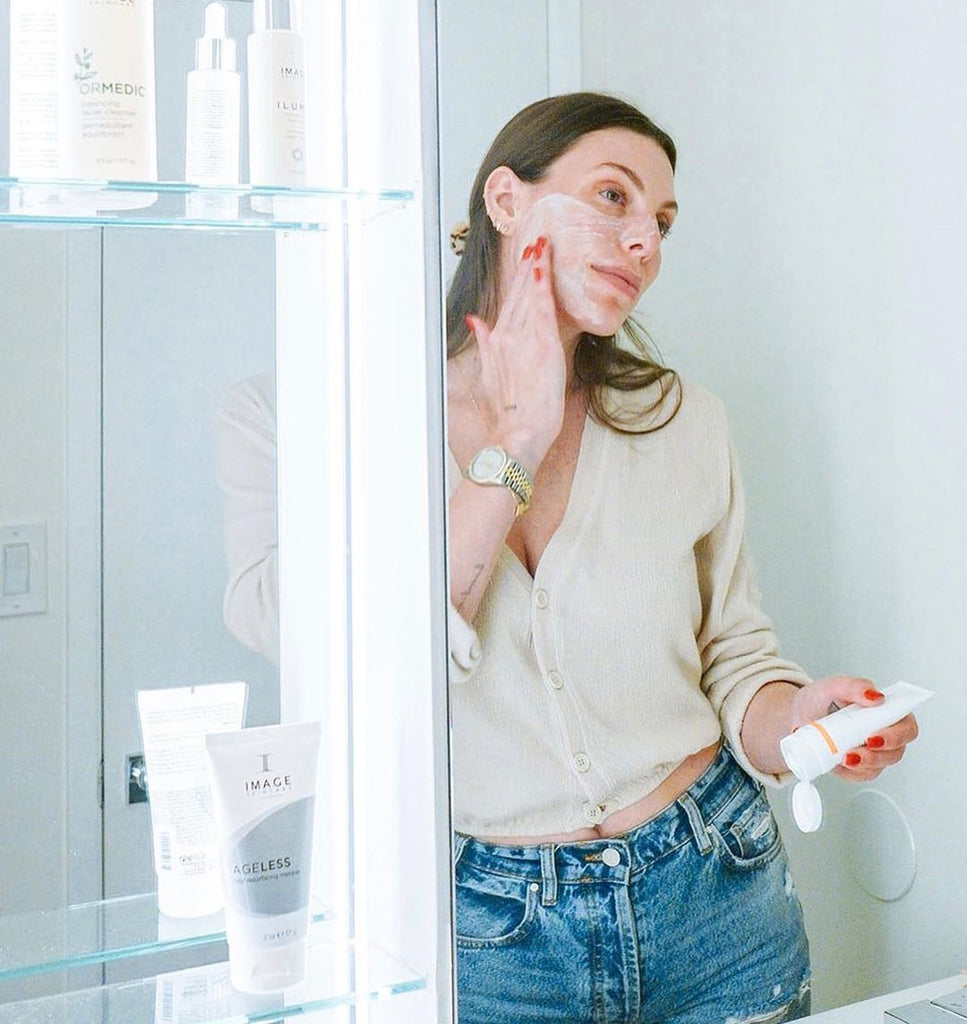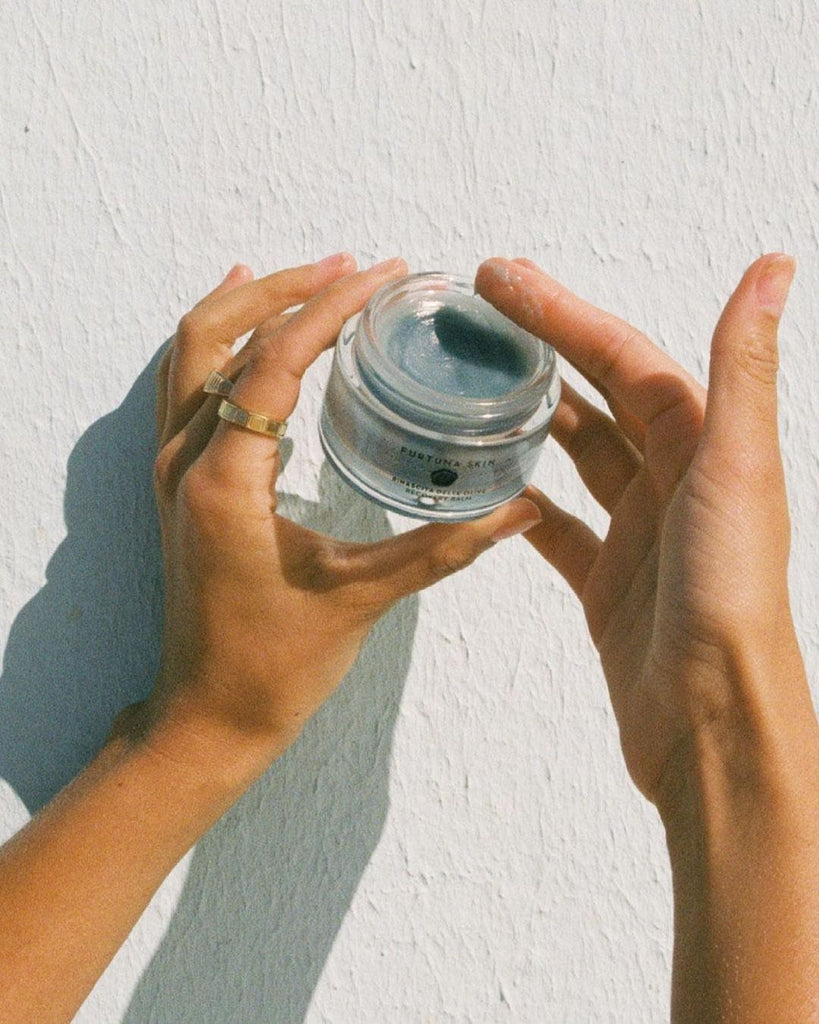2020 already hit us with a new breed of tornado and a new breed of hornet —why not add a new breed of acne to the list? If you’ve been experiencing breakouts on the lower half of your face, you may be suffering from an unsightly situation the internet has dubbed “maskne.” Unlike bacne, a portmanteau that refers to the acne’s location, maskne’s nickname refers to its creator: the face masks worn to mitigate the spread of COVID-19.
Like other types of acne, maskne is a nuisance, but a trickier one to treat since its root cause sits on your face. Factor in a particularly sweaty summer and the daily cortisol-spiking stress of simply existing in the year 2020, and you have the perfect recipe for a never-ending, self-perpetuating breakout. In the name of clearer, less-irritated skin, we asked experts to share how to deal with mask-induced breakouts.
Why do face masks cause maskne?
Face masks are basically little Easy-Bake Ovens that collect and cook a lot of gross stuff on your face. According to Houston-based dermatologist Elizabeth Mullans, masks trap sweat, sebum, saliva, and the miscellaneous bacteria that’s expelled from your mouth up against your skin. Dr. Patricia Wexler explains that all of this gross stuff then sits and thrives in the hot, humid environment that’s created when you breathe into a mask all day. “This damages the skin’s protective barrier, meaning bacteria can then penetrate it and cause pimples, while oil and products clog the pores,” says Mullans.
To make matters worse, face masks also constantly rub against your skin, causing friction and irritation. This can result in red, inflamed, and painful breakouts called acne mechanica, a type of maskne that’s more likely to affect people who have dry, sensitive skin, and health-care and front-line workers who must wear tighter-fitting PPE for long stretches of time.
What do I do?
The best way to deal is to simplify the rest of your skin-care routine. Dr. Sameer Bashey, a dermatologist in Los Angeles and New York City, recommends shifting your prime focus to maintaining your skin’s barrier function, so it doesn’t let all that gross stuff in. “This practice is crucial because it helps your skin combat worsened reactions to irritation and reduces the risk of further flare-ups,” he adds.
Rather than focusing on smoothing wrinkles or sculpting cheekbones, Bashey says to stick with a routine that removes the dirt, oil, and dead skin cells that clog pores and get you stuck in the breakout cycle. Here’s where to start:
1. Wash your face religiously.
“Doing a thorough job cleansing the skin is one of the best ways to prevent maskne before it even starts,” says medical aesthetician and celebrity facialist Candace Marino. “Train yourself to start cleansing your skin before you put on your mask, and as soon as you get home, right after you remove it — don’t wait until right before bed.” Since this shift may mean washing your face more frequently, be sure your cleanser won’t strip or dry out your skin — this only triggers it to create even more oil. Wexler suggests looking for cleansers that are noncomedogenic and gentle for your minimum of at least two cleanses a day.
|
|
|
|
|
$19 |
Biossance Squalane + Tea Tree Cleansing Gel $29
|
ZO Skin Health Gentle Cleanser $45 |
2. Add some gentle exfoliation.
Bashey says to practice regular mild exfoliation to keep your skin in its most optimal state, but don’t overdo it. Going too hard will backfire and leave your skin barrier vulnerable to bacteria and irritation, so cut or at least minimize the use of stronger products like retinol and benzoyl peroxide. For a seamless transition into exfoliating, Marino recommends trying a double cleanse (an oil-based cleanser followed by a milky one) followed by a gentle exfoliator with antibacterial ingredients and enzymes that break down dead skin cells as the third step. (Her client Grimes is a fan of the honey cleanser below).
|
|
|
|
|
CeraVe Salicylic Acid Cleanser $15
|
Dermalogica Daily Microfoliant $59
|
iS Clinical Warming Honey Cleanser $45 |
3. Moisturize and skip makeup.
Once your face is clean, shield it with a moisturizer that locks moisture in and keeps other things out. “Look for products that contain hyaluronic acid or ceramides that protect skin and create a barrier between your skin and the mask material that you’re wearing,” says Wexler. Formulas with a lighter consistency will also prevent pores from clogging, as will skipping any face makeup, if you haven’t officially broken up with it yet. Don’t break up with your sunscreen, though. Layer an SPF 30 or higher over your moisturizer, even if you’re staying inside for most of the day.
|
|
|
|
|
CeraVe Daily Moisturizing Lotion $12
|
Avène Cicalfate Restorative Skin Cream $28
|
$16
|
4. Soothe, spot-treat, and stick other things on your face if necessary.
If you’re well past prevention and need to treat existing maskne, start by seeking immediate relief for anywhere that hurts. Wexler recommends using a cold compress soaked in ice water and skim milk to soothe any redness or scaling. If you’re dairy-free, try a hydrating or soothing face mask (the K-beauty kind) with calming ingredients like aloe.
If your skin isn’t raw and you’re ready to treat affected areas, Wexler recommends either an exfoliating alpha beta peel, a purifying clay mask, or carefully spot treating with benzoyl peroxide, depending on the severity of the breakout. If you’re wearing masks often (the protective kind), Marino recommends taking advantage of acne patches that target breakouts with salicylic acid. An added benefit of patches is that they’ll keep any zits covered and protected from further mask-on-face friction.
5. Find the right mask.
The type of mask you choose can play a role in how bad your maskne gets. Bashey and Marino both agree that disposable masks are the most breathable and least likely to cause breakouts, since they’re discarded before they get too dirty. “Non-disposable cloth fabric also retains more moisture and sweat, which can foster the growth of microorganisms like bacteria and yeast,” Bashey adds.
If you go the reusable route, stock up on several masks to cycle through, and promise yourself that you’ll wash your masks after each use to avoid the aforementioned bacteria and yeast party. Mullans recommends investing in a fragrance-free, hypoallergenic detergent (like the one below), to avoid leftover detergent residue that often irritates already-irritated skin. In terms of mask fabric, Wexler and Mullans say cotton masks are the way to go, just keep in mind that heavier ones can create more sweat during hot and humid weather, and potentially zap your skin’s natural oils when it’s drier out. It may take a few test-drives to find the right model for your skin, but regardless of the season, make sure your mask fits correctly and comfortably to reduce the amount of friction against your skin.
|
|
|
|
|
Sfavereak Disposable Face Mask $13 for 50
|
$15 for 3
|
Arm & Hammer Sensitive Skin Free & Clear Liquid Laundry Detergent $13 |
6. Know when to throw in the towel.
When you’re changing up your skin-care routine, Wexler says a little can go a long way. If you’re not noticing any improvements or things are getting worse, stop and seek professional help as soon as possible. “Remember, everything you see isn’t necessarily acne,” she adds. What you may think is maskne can turn out to be something completely different, like a rash, a cold sore, or hormonal acne, in which case Wexler says it’s time to find a different plan with the aid of a dermatologist.
This article was originally published thecut.com.



